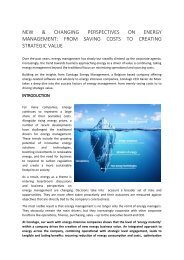Accurate Allocation of energy in production processes - the importance of using metamodels
Many companies struggle with correctly monitoring, allocating and distributing direct and indirect energy consumption over all internal and external customers, users or products. In this age of rising commodity costs and additional attention to sustainability, the advantages of adequately allocating energy are nonetheless substantial: 1. Real-time mapping of energy throughout process flows makes it easier to detect deviations in energy conversions during production processes, find the root causes and reduce losses. 2. Using exact and objective keys for allocating energy consumption speeds up periodic P&L and CSR reporting and makes for more accurate reports. 3. Continuous, real-time distribution of energy cost among users increases transparency and raises awareness with them. Although most companies already struggle with integrating correct data from metered equipment, this is only the first - albeit important - step. The crux is fully understanding the nature and efficiency of energy conversions processes; energy inflows and outflows to different customers; fixed and variable costs and corporate structures. By using metamodels - designed for and maintained by energy managers - all this information is added to the initial metered data and processed in such a way that any change from an energy point of view instantly leads to adjustments in the energy allocation. This white paper reviews emerging trends and challenges in energy allocation and examines the working and benefits of using specific metamodels at the level of energy management software.
Many companies struggle with correctly monitoring, allocating and distributing
direct and indirect energy consumption over all internal and external customers,
users or products. In this age of rising commodity costs and additional
attention to sustainability, the advantages of adequately allocating energy are
nonetheless substantial:
1. Real-time mapping of energy throughout process flows makes it easier
to detect deviations in energy conversions during production processes,
find the root causes and reduce losses.
2. Using exact and objective keys for allocating energy consumption
speeds up periodic P&L and CSR reporting and makes for more accurate
reports.
3. Continuous, real-time distribution of energy cost among users increases
transparency and raises awareness with them.
Although most companies already struggle with integrating correct data from
metered equipment, this is only the first - albeit important - step. The crux is
fully understanding the nature and efficiency of energy conversions processes;
energy inflows and outflows to different customers; fixed and variable costs
and corporate structures. By using metamodels - designed for and maintained
by energy managers - all this information is added to the initial metered data
and processed in such a way that any change from an energy point of view
instantly leads to adjustments in the energy allocation.
This white paper reviews emerging trends and challenges in energy allocation
and examines the working and benefits of using specific metamodels at the
level of energy management software.
Create successful ePaper yourself
Turn your PDF publications into a flip-book with our unique Google optimized e-Paper software.
2. Allocat<strong>in</strong>g shares to s<strong>in</strong>ks and conversion nodes.<br />
As <strong>the</strong> goal is to get to <strong>the</strong> distribution over <strong>the</strong> f<strong>in</strong>al customers (<strong>the</strong> s<strong>in</strong>k<br />
nodes), <strong>the</strong> next step is to fur<strong>the</strong>r distribute <strong>the</strong> share <strong>of</strong> consumption<br />
allocated to <strong>the</strong> distribution and conversion nodes. This describes <strong>the</strong><br />
actual physical flow <strong>of</strong> <strong>the</strong> commodity types from <strong>the</strong> distribution node<br />
<strong>in</strong>to <strong>the</strong> o<strong>the</strong>r nodes (s<strong>in</strong>k and conversion nodes) . It is used to spread<br />
<strong>the</strong> total amount <strong>of</strong> commodity used over all <strong>the</strong> physical users <strong>of</strong> <strong>the</strong><br />
commodity type.<br />
3. Allocat<strong>in</strong>g <strong>in</strong>direct consumption from conversion nodes to s<strong>in</strong>ks<br />
The f<strong>in</strong>al step redistributes <strong>the</strong> flows that have gone <strong>in</strong>to conversion<br />
nodes. All users <strong>of</strong> <strong>the</strong> converted commodity, <strong>in</strong> o<strong>the</strong>r words, will get<br />
<strong>the</strong>ir share <strong>of</strong> <strong>the</strong> primary commodity <strong>the</strong>y <strong>in</strong>directly consume. This<br />
partition is crucial for transferr<strong>in</strong>g all costs - both direct and <strong>in</strong>direct -<br />
for all commodity types to <strong>the</strong> <strong>in</strong>ternal end customers <strong>of</strong> <strong>the</strong> company.<br />
The description above illustrates <strong>the</strong> power <strong>of</strong> graph models. The logic <strong>of</strong><br />
partition<strong>in</strong>g is already built <strong>in</strong>, so to speak. It def<strong>in</strong>es <strong>the</strong> <strong>energy</strong> type sources,<br />
conversions and s<strong>in</strong>ks for all <strong>the</strong> <strong>energy</strong> types provided by <strong>the</strong> company. Meters<br />
can be mapped to <strong>the</strong> flows <strong>of</strong> <strong>the</strong> graph model for all <strong>the</strong> periods relevant for<br />
<strong>the</strong> company - whe<strong>the</strong>r it is weeks or months - and <strong>the</strong>ir totals calculated over<br />
those periods.<br />
Application: conversion efficiencies<br />
The first application is straightforward. For each conversion node, <strong>the</strong> efficiency<br />
<strong>of</strong> <strong>the</strong> conversion is easily calculated us<strong>in</strong>g <strong>the</strong> <strong>in</strong>put and output flows. Every<br />
<strong>in</strong>put-output comb<strong>in</strong>ation gives rise to a particular efficiency.<br />
For example, a comb<strong>in</strong>ed heat power converter has a s<strong>in</strong>gle natural gas flow<br />
<strong>in</strong>put and two output flows, heat and electrical power.<br />
Application: cost allocation<br />
All costs for <strong>the</strong> acquired commodity types like, gas, water & electricity need to<br />
be allocated to <strong>the</strong> <strong>in</strong>ternal customers who use <strong>the</strong>m. In addition <strong>the</strong> costs for<br />
convert<strong>in</strong>g acquired commodity types to derived commodity types (e.g. hot<br />
water, result<strong>in</strong>g from <strong>the</strong> comb<strong>in</strong>ation <strong>of</strong> water and gas) need to be allocated<br />
to <strong>the</strong> <strong>in</strong>ternal customers that use <strong>the</strong>se derived commodity types.<br />
Direct costs are fairly easy to allocate, as <strong>the</strong>y can be l<strong>in</strong>ked to <strong>the</strong> meters which<br />
record <strong>the</strong> commodity type usage. The challenge is to correctly assign <strong>in</strong>direct<br />
19




